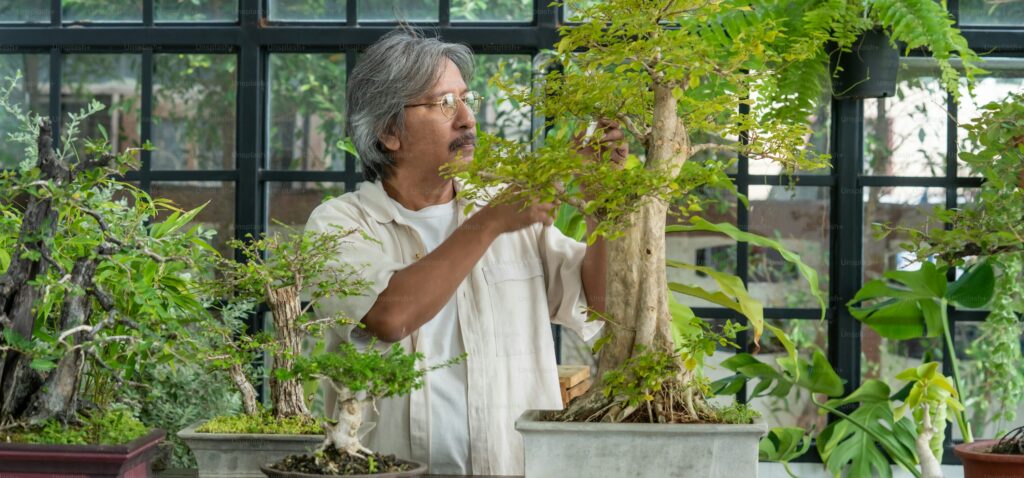
Bonsai is one of those things that might seem a bit mysterious at first glance. You see these beautiful, miniature trees that look like something out of a fairytale, and you can’t help but wonder how they’re made. Are they a special kind of tree? How do they stay so small? And can anyone really grow one, or is it just for experts with decades of experience?
If you’ve ever found yourself curious about bonsai, you’re definitely not alone. These tiny trees have fascinated people for centuries, and they’re much more accessible than you might think. In this guide, we’ll explore the basics of bonsai, how to get started, and why these little trees might be just what you need to bring a bit of peace and nature into your life.
What Is Bonsai, Anyway?
First things first—bonsai isn’t a specific type of tree. The word “bonsai” actually refers to the art of growing and shaping a tree to stay small while looking like a full-sized tree. The practice originated in China over a thousand years ago and was later refined in Japan, where it became an art form.
At its core, bonsai is about creating a living work of art. It’s not just about growing a plant in a pot; it’s about carefully nurturing and shaping that plant over time so that it reflects the beauty and strength of a tree in nature—just on a much smaller scale.
Why Bonsai?
You might wonder why someone would want to spend so much time and effort on a tiny tree. The answer lies in the unique blend of challenge and tranquility that bonsai offers.
For many, working with bonsai is a meditative practice. It requires patience, attention to detail, and a deep connection with the natural world. You’re not just watering a plant—you’re shaping a living thing, and in doing so, you’re also shaping yourself. There’s a certain calm that comes with the slow, deliberate care that bonsai demands, and many people find it to be a soothing escape from the hustle and bustle of everyday life.
Plus, there’s the sheer satisfaction of watching something grow. Seeing your bonsai flourish under your care, knowing that you’ve helped it become what it is—that’s a reward in itself.
Getting Started: Choosing Your First Bonsai Tree
The first step in your bonsai journey is choosing the right tree. And here’s some good news: you don’t need to start with a rare or exotic species. In fact, it’s usually best to start with something simple and hardy, especially if you’re new to bonsai.
Some popular choices for beginners include:
- Juniper: Junipers are incredibly resilient and forgiving, making them an excellent choice for beginners. They’re also evergreen, so they’ll stay green and vibrant year-round.
- Ficus: Ficus trees are known for their adaptability and ease of care. They can thrive indoors, which is perfect if you don’t have a garden or outdoor space.
- Chinese Elm: This tree is a favorite among bonsai enthusiasts for its elegant appearance and ability to thrive in various conditions.
When selecting your tree, consider your environment. Do you have a sunny windowsill? Will the tree be kept indoors or outdoors? Different species have different needs, so choose one that matches your living situation.
The Basics of Bonsai Care
Now that you’ve got your tree, let’s talk about care. Bonsai might seem like it requires a lot of specialized knowledge, but it boils down to a few basic principles: watering, pruning, repotting, and patience.
1. Watering: Watering is crucial, and it’s a bit different from your average houseplant. Because bonsai trees are in small pots, they can dry out quickly. The key is to keep the soil moist but not waterlogged. Check your tree daily by sticking your finger about an inch into the soil. If it feels dry, it’s time to water. Be sure to water thoroughly, allowing the water to soak through the soil and out the drainage holes.
2. Pruning: Pruning is what helps your bonsai maintain its shape and encourages new growth. There are two types of pruning: structural and maintenance. Structural pruning is done to shape the tree, while maintenance pruning keeps it tidy and healthy. Don’t worry about making it perfect at first—bonsai is a long-term practice, and your tree’s shape will evolve over time. Start by removing any dead or overgrown branches, and take it from there.
3. Repotting: Every couple of years, you’ll need to repot your bonsai. This prevents the roots from becoming too crowded and helps refresh the soil. When repotting, trim the roots slightly and use fresh bonsai soil (a mix of akadama, pumice, and lava rock is often recommended). Repotting can seem intimidating, but it’s essential for keeping your tree healthy.
4. Patience: Perhaps the most important aspect of bonsai care is patience. These trees grow slowly, and it can take years for them to develop the desired shape. But that’s part of the beauty. Bonsai teaches you to slow down, to enjoy the process rather than rush to the result.
Shaping Your Bonsai: The Art of Wiring
One of the unique aspects of bonsai is the ability to shape your tree in almost any way you want. This is often done using wire to guide the growth of branches. Wiring involves wrapping the branches with soft, flexible wire and gently bending them into the desired position.
Wiring can seem daunting at first, but it’s a skill that develops with practice. Start by wiring a few branches and observing how the tree responds. Remember, the goal isn’t to force the tree into a shape but to guide it. Over time, you’ll learn to see the potential in each branch and how it contributes to the overall design.
Common Mistakes and How to Avoid Them
As with any new hobby, there’s a learning curve to bonsai. Here are a few common mistakes beginners make and how to avoid them:
- Overwatering: It’s easy to overwater a bonsai, especially if you’re worried about the tree drying out. Always check the soil before watering.
- Neglecting Sunlight: Most bonsai trees need plenty of light. Make sure your tree is getting enough sunlight, especially if it’s an outdoor species.
- Impatience: Bonsai is a slow process. Don’t rush the growth or pruning—take your time and enjoy the journey.
- Ignoring the Roots: Healthy roots are crucial for a healthy bonsai. Don’t forget to check them during repotting and make sure they have enough room to grow.
The Joy of Bonsai: Why It’s Worth the Effort
At first glance, bonsai might seem like a lot of work. And it’s true—these tiny trees require care and attention. But what you get in return is something truly special.
Bonsai is more than just a plant; it’s a living piece of art, a reflection of your creativity and patience. As you work with your bonsai, you’ll find yourself becoming more in tune with nature and more mindful of the small details in life. It’s a rewarding hobby that offers a sense of calm and accomplishment.
So, if you’re curious about bonsai, why not give it a try? Start with a simple tree, learn the basics, and see where the journey takes you. You might just find that these tiny trees have a big impact on your life.







